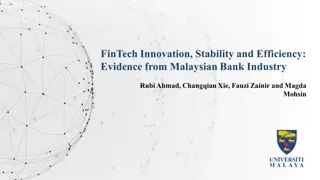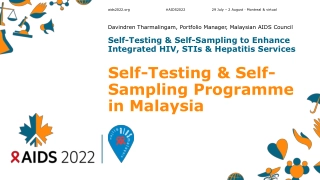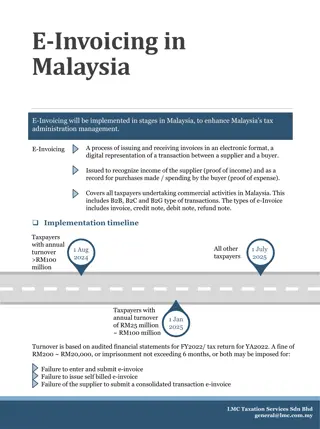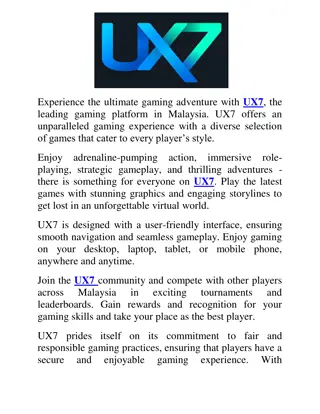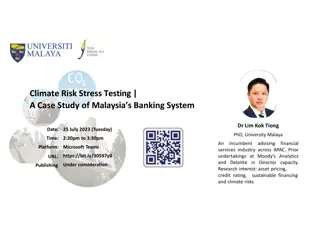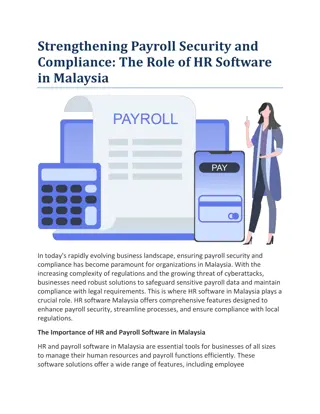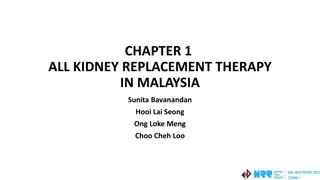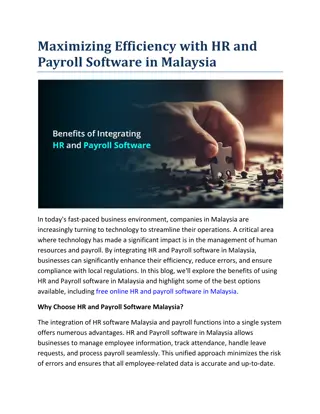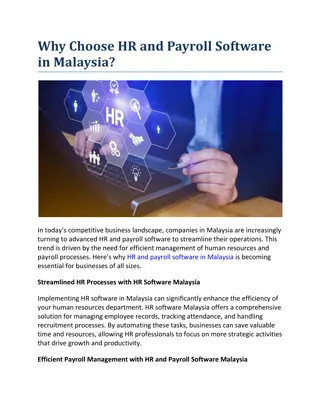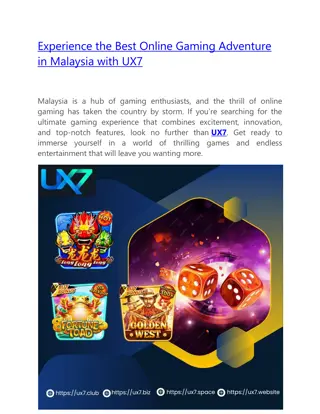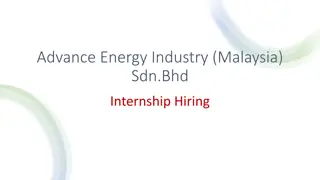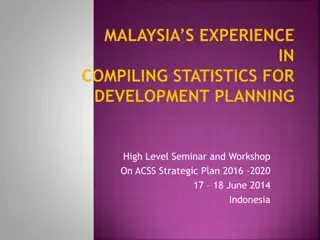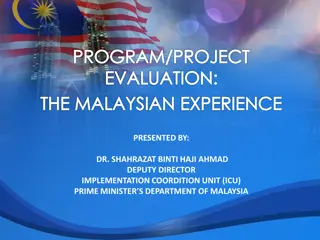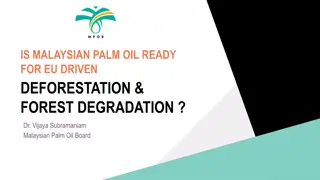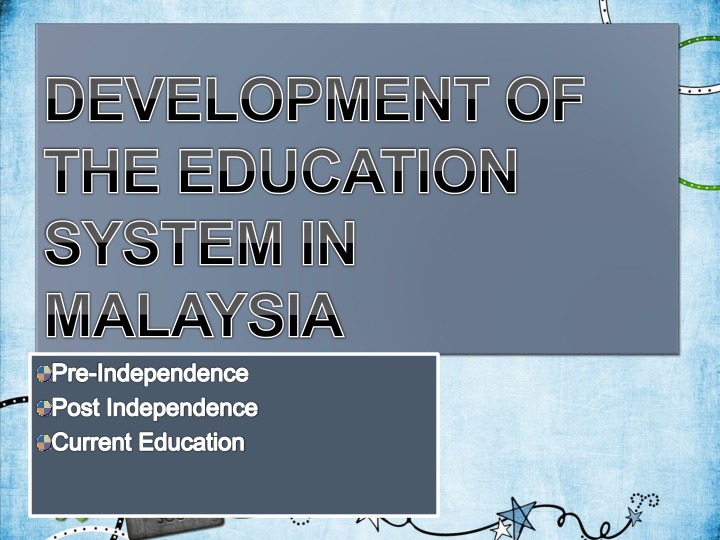
Evolution of Education System in Malaysia: Pre-Independence to Current Trends
Explore the historical development of Malaysia's education system from pre-independence to the current era, including key phases such as British colonization, post-World War II reforms, and the implementation of various educational reports and plans. Discover the transformation of schools, languages of instruction, and important committees that have shaped Malaysia's educational landscape.
Uploaded on | 2 Views
Download Presentation

Please find below an Image/Link to download the presentation.
The content on the website is provided AS IS for your information and personal use only. It may not be sold, licensed, or shared on other websites without obtaining consent from the author. If you encounter any issues during the download, it is possible that the publisher has removed the file from their server.
You are allowed to download the files provided on this website for personal or commercial use, subject to the condition that they are used lawfully. All files are the property of their respective owners.
The content on the website is provided AS IS for your information and personal use only. It may not be sold, licensed, or shared on other websites without obtaining consent from the author.
E N D
Presentation Transcript
DEVELOPMENT OF THE EDUCATION SYSTEM IN MALAYSIA Pre-Independence Post Independence Current Education
The Education System Before Independence (1400 The Education System Before Independence (1400- -1956) 1956) During British Colonization (1786- 1956) Before British Colonization (1400- 1786) Before World War II (1786-1941) Islamic Education After World War II (1946-1956) -Primary & Secondary Education -National Teacher Training -Vocational & Technical Education -Higher Education -Cheeseman Plan (1946) -Barnes Report (1951) -Fenn-Wu Report (1952) -Education Ordinance (1952) -Razak Report (1956) -National Teachers Trainee -Higher Education - Teacher s house -Mosque, surau, & madrasah -Pondok/hut
EDUCATION EDUCATION SYSTEM: SYSTEM: PRE PRE- - INDEPENDENCE INDEPENDENCE
3 phases of Colonial period: 1786-1941 [Divide and Rule] 1941-1945 [Japanese occupation] 1945-1957 [After Japanese occupation]
There were 4 types of school during British colonization. English-medium. Malay-medium. Chinese-medium. Tamil-medium.
Education After World War II (1946-1957) The Cheeseman Plan. The Barnes Report. The Fenn-Wu Report. The Education Ordinance. The Razak Report. The Rahman Talib Report. The Education Act 1961.
THE CHEESEMAN PLAN 1946 Free basic education for all. Medium of instruction in secondary school: English language Malay language Mandarin Tamil English language compulsory for all vernacular schools.
The abandoned in 1949 with the demise of the Malayan Union. The Barnes Committee was set up in 1950 to look into integrating the educational system. Cheeseman proposal was reforming and
1951, THE BARNES REPORT Proposed schools standard & become national school using the same syllabus with bilingual languages; Malay & English. Secondary schools had to maintain English as medium of instruction. Replacement of Islamic education. all primary vernacular one maintained single Jawi script with
1952, THE FENN-WU REPORT Medium of instruction for vernacular schools are English, Mandarin and Malay. Argument: Country still can achieve unity though there was diversity in the medium of instructions.
1952, THE EDUCATION ORDINANCE Based on Barnes Report. 5 types of schooling systems: English schools with English as medium of instruction. Malays schools with Malay as medium of instruction. Chinese schools. Tamil schools. Religious schools. Curriculum according to individual school system.
1956, THE RAZAK REPORT Chaired by Dato Abdul Razak Hussein. Received 151 memorandums. The report proposed: One common school system for all: Malay language as the medium of instruction for all stages of schooling. Centralized curriculum & school examination.
Both types of primary school should enforce Malay as a compulsory subject. All national secondary schools should use a common syllabus & examination & enforce Malay & English as their compulsory subjects. All teachers should be trained with a common syllabus in teachers training colleges.
EDUCATION EDUCATION SYSTEM: SYSTEM: POST POST INDEPENDENCE INDEPENDENCE
1960, THE RAHMAN TALIB REPORT Malay language as main language in schools. Free secondary school education. Automatic promotion until form 3. Establishment of technical & vocational schools. Emphasis on religious & moral education.
THE EDUCATION ACT 1961 Aspect Elaboration Levels of education i. ii. iii. Upper secondary school education. iv. Education in other educational institutions; eg: colleges, teacher training colleges, etc. i. Compulsory for all children of school-going age ii. Free for all. iii. Offered in national schools & national-type schools. i. Normal lower secondary ii. Normal upper secondary iii. Trade iv. Technical (upper secondary) v. Vocational (upper secondary) vi. Secondary (approval from Ministry of Education i. Only offered if there were more than 15 Muslim pupils. ii. Taught by trained Agama teachers. iii. Two periods a week during school hours. Primary school education. Lower secondary school education. Primary education Secondary education Islamic Education
HUSSEIN ONN REPORT 1971 Provide a basic education for all children of school-going age. Acknowledge the Malay language as the main medium of instruction. Maintain the status of English language as second language. Time allocated for teaching of English language will be increased & teachers given the necessary training.
1979, MAHATHIR REPORT Chaired by Dr. Mahathir bin Mohammad. Main objective: to review the goals and effectiveness of the present education system for the purpose of meeting the manpower needs of the country both for the short and long terms. Besides this, to also ensure that the education system meets the country s goals of producing a united, disciplined and skilled society.
Recommendations: Focus on the 3 basic skills; reading, writing & arithmetic. Teaching of English language as a second language. Emphasis given for a sound spiritual education & other disciplines, wherever appropriate. Secondary education to be divided into two streams; academic & vocational. Extension of educational opportunities from 9 to 11 years. Emphasis on curriculum ala Malaysia. Review of Bahasa Malaysia in-service courses.
EDUCATION EDUCATION SYSTEM: SYSTEM: CURRENT CURRENT EDUCATION EDUCATION
Education act 1996 Aims: To further consolidate the national education system for the young generation in accordance with the country s aspirations of making Malaysia a center of excellence for education. To outline the legislation related to education. 3 general legislative provisions: The National Philosophy of Education which was proclaimed in 1988 & forms the underlying basis;
The consolidation of the national education system to include the following: All levels of schooling, from pre-school until tertiary education; All categories of schools, for government-aided schools & private schools; The National Language became the main medium of instruction under the national education system, besides being a compulsory subject for all schools & educational institutions. example, government schools,
National Philosophy of Education 1989 "Education in Malaysia is an on-going effort towards further developing the potential of individuals in a holistic and integrated manner, so as to produce individuals emotionally and physically balanced and harmonious, based on a firm belief in and devotion to God. Such an effort is designed to produce Malaysian citizens who are knowledgeable and competent, who possess high moral standards, and who are responsible and capable of achieving high level of personal well-being as well as being able to contribute to the harmony and betterment of the family, the society and the nation at large." who are intellectually, spiritually,
National Education Policy Goals: To produce a united bangsa Malaysia; To produce Malaysian citizens who are knowledgeable, God- fearing, well-behaved, competent & harmonious. To provide a competent work force to meet the needs of a growing nation To offer equal educational opportunities for all Malaysian citizens.
ETeMS Teaching of Mathematics & Science in English (ETeMS) began in 2002. Aim to ensure that our country would not be left out in the globalisation era. Complete abolishment of ETeMS on the year of 2012
Compulsory Education Compulsory for parents to send children to school. Duration of compulsory schooling is 6 years. Failure for parents to register their children to school will be fined by the law with RM5000 or prison sentence not more than 6 months or both. Reasons: Various ethnic groups to have equal access to education. Rights of children with poverty are uphold.
Elective Subjects Rationale: An inadequate number of pupils in Government schools. An increase in the number of non-Chinese pupils in Chinese vernacular schools. Examples of elective subjects in school: Chinese Tamil Kadazandusun Iban etc.
Smart School Rationale: To achieve Vision 2020 & to keep pace with rapid development in the era of science & technology. The establishment is supported with technology initiative. Promote the development of a work force prepared to meet challenges of the next century. Concept: A change in the learning culture based on memory & examination- orientation to creative thinking & problem-solving.
Goals: To produce a knowledge-based work force who will navigate our country towards an information-based economy. Students will be absorbed into the workforce for the Multimedia Super Corridor. Assist in the transformation of technology ultimately leading to a highly technology-based local industry. Implementation: Production of a computer-savvy workforce equipped with thinking-skills Democratisation of education. Increment of stakeholders involvement. Holistic development with due consideration to individual capability. Emphasis on physical, emotional, spiritual & intellectual domains.
Strategies: A multi-perspective curriculum which encompasses elective subjects Vertical, horizontal & multi-disciplinary integration. Reasoning, values, creativity & language across the curriculum. Use of technology in teaching & learning. Care & concern for diversity in learning abilities & styles. Levels of Technology: Level A: 9 new school equipped with modern technology. Level B+: 2 Smart Schools equipped with computers in 15 science laboratories, classrooms & office. Level B: 79 Smart Schools equipped with a laboratory & computers in the Resource Center & computers for teachers.
Vision Schools Aims: Initiative to produce a Malaysian race (bangsa Malaysia) built on love for the country & abolition of ethnic differences amongst its citizens. The importance of fostering racial unity early in an individual s life. Concept: Nation Primary School, Chinese National-type Primary School & Tamil National-type Primary School will have their students to study in a common area.
Rationale: Pupils from diversified races interact with one another from an early thus ensuring that our country is moving towards national unity. Issues: Inculcation of ethnic & cultural diversity through printed & non-printed materials, co-curricular activities & celebration of festivals. Equality in the implementation of school rules in accordance to the culture & beliefs of each ethnic group. Academic & non-academic staff of all races to enhance social interaction with the pupils. Fostering of positive ethnic identity awareness & the absence of superiority or inferiority complex founded on ethnicity. Open communication across ethnic groups through interaction during recess & co-curricular activities.
Considerations: Inadequate practice of collaborative teaching for pupils to be exposed to & comprehend different cultural & social viewpoints. Inadequate specialized training for Vision Schools teachers in areas such as cross-cultural communication skills, cultural sensitivity. Balance between teachers & pupils background so as to bridge the social gap & enhance mutual understanding. Challenges: Encounter stiff challenges from the private sector & community. Eg: Chinese schools were reluctant to get themselves involved will probably lead to a loss of the Chinese identity & culture.
Basic Reading & Writing Classroom Intervention Program (KIA2M) Why? The problem of pupils failure to master basic reading and writing skills was a huge concern & given serious attention. Goals: To assist Year 1 pupils to master the basic reading & writing skills in the Malay language. To provide opportunities for pupils to learn according to their individual ability levels. To enhance pupils self-confidence To nurture an interest for learning. KIA2M is compulsory for all national schools whereas national-type schools are given option.
Those who need to be sent to a special remedial class Target Group- Year 1 pupil The slow learners who have yet to master the basic reading and writing skills Those who need remediation in class
1 Nomination 2 6 Screening test Follow-up 6 Steps of Teaching & Learning Strategies 5 3 Evaluation Planning 4 Teaching
Steps Details Nomination & Screening Test Based on the number of Year 1 pupils. No addition to the number of classes or teachers. Students initially undergo a nomination process and screening test before get selected. Pupils are classified into test scores: 0-9: Referred to medical practitioner 10-44: Undergo KIA2M program 45-60: Continue with teaching and learning in a normal class. Teachers plan their teaching using teaching module provided as a guide and reference. Teachers are given autonomy to modify the activities and exercises in the module according to pupils abilities. Planning
Suggested Strategies Planning and implementation of teaching is carried out by the teacher on an individual basis. Pupils are required to follow the teacher s instructions and learn what has been taught. Teacher- centered Active pupil involvement in all the activities planned by the teacher, on an individual, group or class. Pupil- centered Learning materials are prepared and arranged to be used by pupils after they have been given clear explanations by the teacher. Resource- centered
CHOICE OF APPROACHES Individual Approach Focus on one student only. Peer assistance can be sought (if necessary). Group Approach Pupil-centered. Pupils who are facing the same or almost the common learning problems. Teacher teaches using the module provided. Class Approach Pupils involve themselves in group activities to help foster their self-confidence.
TEACHING Story- telling Quizzes Drills Techniques Suggested Demons trations Plays Questio n-and- answer Songs Role play
EVALUATION AND FOLLOW-UP KIA2M pupils are allowed to go back to mainstream if they passed: Ujian Pelepasan 1 Ujian Pelepasan 2 Observation & monitoring: Curriculum Development Center & other interested divisions in the Ministry of Education School Inspectorate State Education Departments District Education Offices School heads (Headmasters @ headmistress)
Education Development Master Plan (EDMP) 2006-2010 Goals: To produce quality education for all through the following 2 main approaches: 1stApproach: Ensure equity & equality. Strategies: Given fair & just educational opportunities. Given the opportunities to master 3R: Reading, Writing, Arithmetic. Improvement of ICT access.
2ndApproach: Fully develop the potential of all schools. To fall within the excellence cluster. Achieve measurable success to chart our country & the education system on the world map. Strategies: Identify cluster schools from the following types of schools: National National-type Boarding Premier Secondary technical National religious secondary Centennial Smart Schools Schools situated in Putrajaya & Cyberjaya. Introduce various programs to enhance the strengths & competitiveness of schools in the education cluster.
EDMP 6 STRATEGIC THRUSTS T1: Nation- building T6: Accelerating Excellence of Educational Institutions T2: Developing Human Capital EDMP T3: T5: Enhancing the Teaching Profession Strengthening National Schools T4: Bridging the Education Gap
Education And Vision 2020 Aim: To gain the status of "a fully developed country" for Malaysia by the year 2020. "By the year 2020, Malaysia can be a united nation, with a confident Malaysian society, infused by strong moral and ethical values, living in a society that is democratic, liberal and tolerant, caring, economically just and equitable, progressive and prosperous, and in full possession of an economy that is competitive, dynamic, robust and resilient."
9 challenges as stated in Vision 2020: 1) The challenge of establishing a united Malaysian nation with a sense of common and shared destiny. This must be a nation at peace with itself, territorially and ethnically integrated, living in harmony, full and fair partnership, made up of one "Bangsa Malaysia" with political loyalty and dedication to the nation. 2) The challenge of creating a psychologically liberated, secure and developed Malaysian Society with faith and confidence in itself, justifiably proud of what it is, of what it has accomplished, robust enough to face all manner of diversity. This Malaysian Society must be distinguished by the pursuit of excellence, fully aware of all its potentials, psychologically subservient to none, and respected by people of other nations. 3) democratic society, practicing a form of mature consensual, community-oriented Malaysian democracy that can be a model for many developing countries. The challenge of fostering and developing a mature,
4) The challenge of establishing a fully moral and ethnic society, whose citizens are strong in religious and spiritual values and imbued with the highest of ethical standards. 5) The challenge of establishing a matured, liberal and tolerant society in which Malaysians of all colours and creeds are free to practice and profess their custom, cultures and religious beliefs, yet feeling that they belong to one nation. 6) The challenge of establishing a scientific and progressive society, a society that is innovative and forward-looking, one that is not only a consumer of technology but also a contributor to the scientific and technological civilization of the future.
7) The challenge of establishing a fully caring society and a caring culture, a social system in which society will come before self, in which the welfare of the people will revolve not around the state or the individual but around a strong and resilient family system. 8) The challenge of ensuring an economically just society in which there is fair and equitable distribution of the wealth of the nation, and there is full partnership in economic progress. Such a society cannot be in place so long as there is the identification of race with economic function, and the identification of economic backwardness with race. 9) The challenge of establishing a prosperous society, with an economy that is fully competitive, dynamic,
Strategies to achieve VISION 2020 Vision 2020 emphasizes Malaysia as a fully developed country, which is developed in every economically, politically, psychologically and culturally. The National Philosophy "developing the potential of individuals in a holistic and integrated manner, so as to produce individuals who are intellectually, spiritually, emotionally and physically balanced and harmonious". aspect spiritually, - socially, of Education calls for
Introduce the subjects of Islamic Studies and Moral, which are compulsory for students. Increasing the intake of Science students. Encouraging the use of computers and multimedia technology in educational courses in Information Technology. The government is already in the process of setting up 90 pilot Smart Schools. These schools are one of the 7 flagships of the Multimedia Super Corridor (MSC) project and aim at transforming the education system from memory-based learning into simulative thinking and creativity, through access to modern technology. institutions and providing

